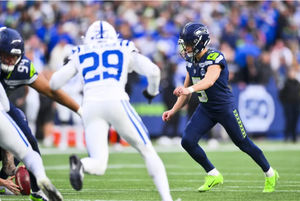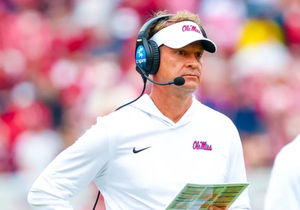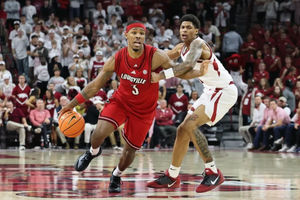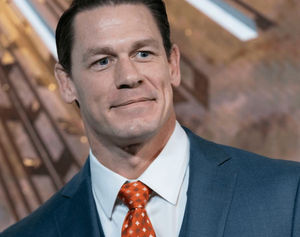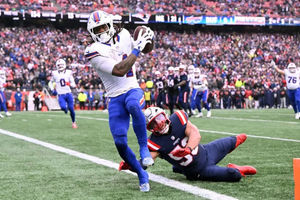If USA Gymnastics Goes Down, Who Goes Down With It?
 credits: Chelsea Beck | source: GMG
credits: Chelsea Beck | source: GMG Last month, Michigan State settled with 332 victims of Larry Nassar’s sex abuse for half a billion dollars. While it’s still unclear how exactly MSU will pay out that substantial settlement, the prevailing wisdom is that some combination of insurance, public funds, loans, and university money will cover it. It was clear from the outset that a public university like MSU was going to survive this scandal, if perhaps not with its reputation or credit rating perfectly intact. This would’ve been true even if the settlement amount had been larger than $500 million. In the profoundly depressing phrase given to us by the 2008 financial crisis, Michigan State is “too big to fail.”
The same cannot be said for USA Gymnastics. Though it is large and successful by the standards of national sports governing bodies, with revenues in 2016 of $35 million—albeit with expenses totaling $32 million—that money is a drop in the bucket compared to what a major public university like MSU brings in. MSU also has access to public money and, like most universities, a sizable financial endowment. While we’re parsing, that $35 million figure is probably a little bit misleading, given that USA Gymnastics’ 2016 revenue represents an Olympic year that featured a dominant performance by the U.S. women’s gymnastics team, including the greatest gymnast of all time, Simone Biles. It’s unlikely that the organization will report the same revenue for 2017 and 2018 after a barrage of bad press and pressure from survivors caused most of their major corporate sponsors—like Kellogg’s, Procter & Gamble, and Hershey’s—to drop them. It’s unclear how significant the revenue decline in 2017 and 2018 will be since that information is not yet public, but it stands to reason that those drops in revenue exist.
And then there are the legal costs. Since September 2016, when the Indianapolis Star reported that former team doctor Larry Nassar had sexually abused gymnasts under the guise of care, USA Gymnastics has been defending itself against hundreds of civil claims. The organization recently sued its seven insurers for failing to pay their defense costs in the ongoing litigation.
In short, members of USA Gymnastics have every reason to be worried about the future. And that worry isn’t confined to the people administering the sport from the national office in Indianapolis, either, although they have reason to worry, given that USAG recently laid off several staff members. The grassroots of gymnastics are worried, too—not just about the future of the nation’s most powerful gymnastics organization but about how that organization’s rocky future might complicate and imperil the smaller organizations that will produce the next generation of gymnasts.
The elite portion of gymnastics—the bit that captivates the nation for a couple of weeks every four years—is its most visible part. That has held true in the reporting on the Nassar scandal: The dynamics of the elite program have been carefully analyzed because the most recognizable Nassar survivors—Olympic gold medalists Aly Raisman, McKayla Maroney, and Jordyn Wieber—are products of the elite gymnastics program.
But gymnastics in the United States is much bigger than the Olympics or the elite level. According to USA Gymnastics’ stats, there were 125,216 athletes members registered with the organization during the 2015-2016 season. That number far exceeds the number of elite female gymnasts—sometimes as few as 30— that there are in the U.S. during any given year.
And if USA Gymnastics goes belly up due to the pending litigation, much more than the national team and Olympic team preparation and selection will be disrupted. The sport could be adversely impacted at every level, and not just because most gyms, coaches, and athletes are affiliated with USA Gymnastics and pay dues to the office in Indianapolis. USA Gymnastics holds millions of dollars in funds that the various states and regions have raised, but which don’t technically belong to USA Gymnastics, on their books. For grassroots gymnastics organizations, losing this money may impede their ability to train athletes and coaches.
Here is how USA Gymnastics is organized at the local level: Each state has a director, one for men’s gymnastics and one for women’s. These are volunteer positions. The 50 states are carved up into eight regions for the women and nine for the men. The states and regions, raise money through their various activities—hosting competitions and clinics, mostly. If a state hosts a clinic, they will charge a fee for the gymnasts and that will go to pay the clinician or rent for a venue. Leftover funds are then deposited in the state’s or region’s account, depending on who is doing the hosting and the organizing.
That’s where USA Gymnastics comes in. In May 2010, according to the 2016 990, USA Gymnastics took those accounts in-house.

USA Gymnastics did not take money from these accounts to use for its own purposes; rather, it would manage the accounts for the states and regions as a “fiscal agent”—cutting checks from their accounts when they sent in expenses, depositing new funds, and other similarly boring stuff—and would then include these account balances in their tax filings. This way, each and every state and region wouldn’t have to create nonprofits in order to handle the money they were taking in nor would they have to file tax returns since it was being done for them; these are volunteers, after all. USA Gymnastics didn’t charge the states who turned over their funds—and, by the way, not all did—for these services. The arrangement that the states and regions had with USA Gymnastics seemed like a good thing right up until USA Gymnastics was hit by a barrage of lawsuits stemming from Nassar’s sexual abuse of hundreds of gymnasts during the two decades he was the doctor for the women’s national team.
Ben Fox began told me he started worrying last year. Fox, the Oklahoma men’s state director and the director of the Bart Conner Gymnastics Academy, said he reached out to the national office and asked about whether the state and regional funds on USA Gymnastics’ books are vulnerable. “I called, asking about some scenarios and things, if there is a better way to protect it,” he told me. Fox said that he was told the office would look into it. He followed up several times over the next five months but didn’t get an answer about the safety of the regional and state accounts.
“I had kind of gone back and forth and exhausted a number of avenues, whether it was board members or people/officers in the organization and nothing was getting done and everybody felt everything was fine,” he said. “I didn’t really feel it was fine.” The loss of these funds would endanger their grassroots activities and would be especially damaging for the men’s programs, which operate on a shoestring budget relative to the women’s programs, which are pretty flush with cash. Fox, who is also a CPA, said that sometimes his organization used its surplus on helping kids who qualified to nationals make that trip; sometimes they paid for coaches to go to education courses. “We raise it through meets and things that we do in the state,” he said. “And we spend it on the kids and the coaches within in the state.”
Jerit Pogue, a gym owner in Texas and the men’s chairman of Region 3, which encompasses Texas, Arkansas, Louisiana, Missouri, Kansas, and Fox’s state of Oklahoma, described some of the activities that Region 3 has funded from the money they raised. “We do three different training camps every summer for the athletes that qualify for [them]. We do clinics. We do coaches’ education.” He also said that he used their funds to bring a team to the Elite Team Cup, a relatively new competition for the men that is held in conjunction with the American Cup.
While the amounts in some of the accounts are not significant—this is especially true with some of the men’s accounts—taken together, the balances add up to millions of dollars that could come into play in the pending litigation. On the nonprofit’s 990s, the state and regional account balances are listed in the Schedule D section under “Escrow and Custodial Arrangements.” The ending balance for 2016 fiscal year was $5,038,003. (In other tax documents on USA Gymnastics’ site, this money is described as “held for others.”)


USA Gymnastics also holds the money of the Pan American Gymnastics Union, which is the governing body for gymnastics in the Americas. PAGU is one of four continental unions under the auspices of the International Gymnastics Federation. According to the most recent documentation I could find, USA Gymnastics is holding approximately $94,000 for PAGU.
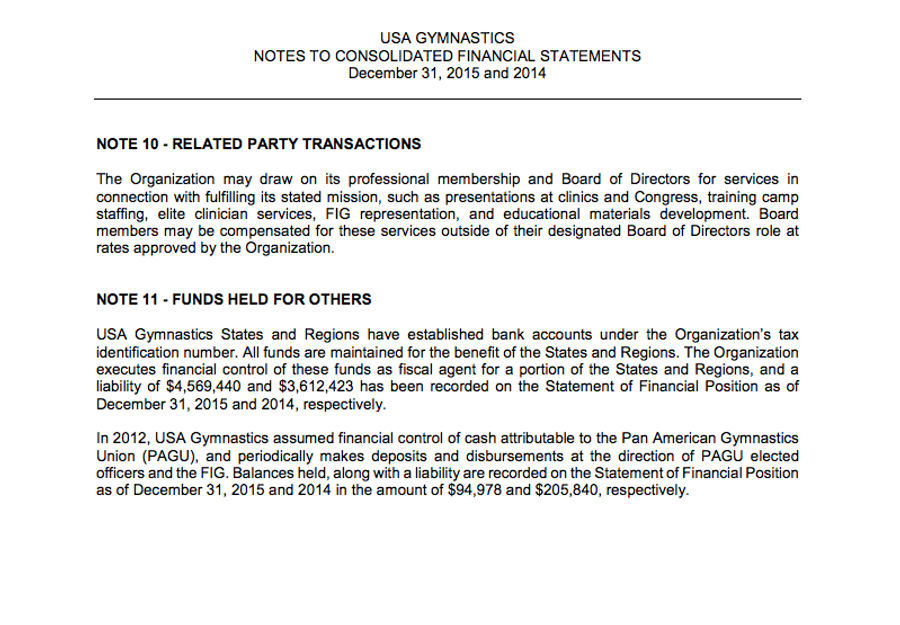
Pogue said he reached out to Fox with his concerns about the regional accounts and learned that Fox was already working on a way to better protect the funds. Fox told me that he consulted with others, including lawyers, and decided to set up a new nonprofit that could accept funds from states and regions that wanted to join.
And in an email dated January 31, Fox explained his new venture to all of the state and regional directors. President and CEO Kerry Perry and longtime comptroller John Hewett were CC’d. Fox wrote:
“Many of you, as I am, are holding checks and worried that if you send the money to the office, that it could be taken by courts or not available for your use. I would like to set up a new financial account that will be called the American Gymnastics Sports and Education Programs, Inc. This financial entity will be a place for you to send and have your funds protected.”
He explained that the new accounts would work just as their USA Gymnastics accounts had: Directors will be able to deposit funds and access them as needed. He also explained that the new organization was in the process of getting a nonprofit ID number from the IRS and that Bart Conner Educational Programs, Inc. had agreed to front the startup costs.
Fox recommended that those who are interested in creating an account with them draw down their accounts with USA Gymnastics by continuing to use the balance to cover their expenses as usual while depositing new monies they raise through their various state and regional activities with the new nonprofit.
The funds these organizations have in their current accounts are commingled with the rebate money that USA Gymnastics issues regions based on membership size. Pogue described these rebates as quite small relative to the overall balance. Fox was emphatic with me that the new enterprise would not accept any deposits that had been commingled with rebate money from USA Gymnastics.
In the initial email, Fox also said that he’d be open to sending reports about the new accounts to USA Gymnastics, but made it clear that they’d have no control over the new entity.
Fox’s blast to state and regional directors prompted a response from Hewett, who tried to reassure the volunteers but acknowledged that he couldn’t make any guarantees. “We have both quality insurance and quality representation, but the possibility exists that judgements could exceed those coverages,” Hewett wrote. “As discussed at the Congress meeting, and with Ben, there is little that can be done to insulate current balances.”
Hewett acknowledged that Fox’s idea of creating a new entity to handle future deposits has some merit, but notes that it is also not without risk. “There always exists the possibility that any new entity (XYZ corp) with ‘re-directed assets’ could be subject to a new claim, subject to whatever insurance coverage the new entity would be able to provide,” Hewett explained. “For example, if a particular state was conducting a state championships, with a sanction through USA Gymnastics, in the event of a liability claim with a negative outcome, the new entity and/or its insurance could likely share in any damages or claims amounts. To the extent it exceeded insurance coverage, the assets of XYZ would be at risk.” He also noted that the state and regional directors could risk far more exposure in a new venture. They could go from being secondary players to being on the front lines. Hewett urged state and regional directors to proceed with caution.
When I asked Fox about the concerns that Hewett raised about the new nonprofit, Fox conceded that his venture could also be at risk. “Nothing is 100 percent foolproof, I don’t think. But it’s a way higher percentage and much better protected than going through them.”
Pogue also acknowledged that this gambit may not work. “We don’t know that it’s 100 percent safe from litigation,” he told me.
Fox sent another email with more information about this nonprofit—the names of the officers on the board (Pogue is one), which bank they’re working with and who to contact there, the status of their IRS nonprofit application. Hewett followed with another email, saying that they will be convening a group, which would include Fox, to discuss the matter. The group also featured one of their insurance reps and two lawyers—Tom James, the USA Gymnastics legal counsel, and their litigation counsel from Faegre Baker Daniels.
Hewett, once again, urged caution. He also quibbled with the language Fox used in his initial email volley. “Representations were made in previous emails that USA Gymnastics ‘controls’ the funds,” Hewett wrote. “Fact of the matter is that you, as chairs, control the funds, including who gets paid, how much, and when. USA Gymnastics administrates the funds, offering perspective when issues such as those dealing with NCAA eligibility or IRS ramifications crop up.”
Whether or not “control” is the correct word, “that money is on their balance sheet,” Fox noted, “and is in danger for being taken for any reason at all.” Fox believes this shouldn’t simply be viewed solely as a Nassar problem. If USA Gymnastics was financially mismanaged, state funds could be lost. If they were sued for other reasons, that money could be lost. “This money should have never been in USA Gymnastics,” Fox said.
When I reached out to USA Gymnastics to speak to Hewett, I was told to submit my questions via email, which I did. I sent seven questions; two addressed the prospect of a bankruptcy filing. The rest dealt with the status of the state and regional accounts and Fox’s new nonprofit. The only response I received was the following: “USA Gymnastics has taken no steps toward filing for bankruptcy and has no intention to do so. Any rumors to the contrary are false.”
Beyond the back and forth between Hewett and Fox, the email chain contained more than 100 people. Some from the women’s program chimed in, not with questions about the proposed entity or substantive critiques of it. Instead, these responders, at least from the emails I saw, professed loyalty to USA Gymnastics.
“Missouri is a USA Gymnastics state and will remain so,” read one such response. “Please remove me from your list.” (I reached out to the state director from Missouri about her email and have not received a response.)
While it is totally fair to debate whether or not Fox’s proposal is a good idea and whether it offers greater protection for the funds in question, it was odd to see responses to it framed in terms of loyalty. What Fox is proposing isn’t a desertion of USA Gymnastics and he didn’t suggest that members stop paying dues to the organization. And these accounts are not used for the day-to-day operation of the NGB, which means that depriving USA Gymnastics of the funds therein wouldn’t cripple the organization. It would have no impact on its operation at all.
“This is not a referendum against USA Gymnastics. Some people, some of the women chairmen that I talked to see it that way,” Pogue said. “This is just us protecting the money that we raised and that’s the bottom line.”
That said, Fox believes that if USA Gymnastics were to lose the state and regional funds due to the current litigation, it could unravel the organization. “If they lose the money, do you think anyone in the grassroots will trust anyone in this organization to do anything correctly?” he asked. Not that the grassroots are necessarily thrilled with USA Gymnastics at the moment. “It has been damaged a lot,” Fox said of the trust between rank and file members and the national office.
That the calls for loyalty came from directors on the women’s side underscores the different relationships that the men’s and women’s programs have with the national office. In most sports, male athletes are the marquee attractions, and are better paid and supported. Gymnastics is the opposite. Women’s participation in the sport in the U.S. far outstrips that by men and the sport’s biggest stars have long been female. Jessica Howard, a Nassar survivor and former USA Gymnastics board member, spoke about the power the women’s program wields inside USA Gymnastics after the Senate hearing on Tuesday. “With the women’s program, after being on the board, I know the women’s program is the most powerful program. They get almost anything they ask for,” she said.
The women also rake in substantially more money both in dues and sponsorships for USA Gymnastics than their male counterparts. “My region has a good amount of money,” Pogue said, “but the Texas women have three times as much money as we do. As the men’s region. That’s just the state of Texas.”
Pogue noted that the women’s state and regional chairs have had a conference with Kerry Perry. Women’s Region 4 had a note about the meeting on their website. “But we haven’t gotten the same thing on the men’s side,” he said. “We want to know what’s going on. We want to have answers to these questions as far as how things are going,” Pogue said.
(USA Gymnastics, when reached for comment, said that Perry has met with the men’s program committee. “Efforts were made to have a meeting with the men’s state and regional chairs, but the busy end of the Junior Olympic season and the competitive state, regional and national schedules precluded it from happening. A meeting with the state and regional chairs for men’s gymnastics will be scheduled in the near future,” USA Gymnastics said in a written statement.)
Pogue said that this treatment isn’t exactly new and that the men have always had to be a bit more self-reliant. “We’ve always kind of been of the mindset that we’ve got to take care of ourselves and take care of our own,” he said. “You know, that’s just the way we’ve always operated.”
Given that pre-existing schism, it’s not at all surprising that the participation in the new entity has mostly been restricted to the men’s side of things. “We have a couple of regions and about 9 or 10 states, mainly in the men’s program,” Fox told me when I asked about who has joined. “Some others have expressed interest, I think. Some of them just kind of wanted to wait and see.”
“No one really knows what’s going to happen in the next six months, year, or two years with all these lawsuits and everything else,” Pogue said. “There’s some that are just kind of operating more cautiously and just feel like well, you know, ‘I’m not sure what to do.’”
Uncertainty dominates U.S. gymnastics in 2018, and probably for the foreseeable future as well. No one knows if USA Gymnastics will survive the litigation headed its way or collapse under its weight. No one knows whether the state and regional funds are vulnerable or safe. But what is striking is the difference in the way that people like Fox have approached the situation and the way that the national office has responded. Since 2016, USA Gymnastics has been largely reactive in this crisis. Steve Penny, who presided over the organization during much of Nassar’s abuse and also mishandled the allegations against him by waiting five weeks to report him to law enforcement, was quite obviously a liability, and yet it took both extended media attention and pressure from the USOC to get him to resign. Ditto for the board resignations and closing the training site at the Karolyi Ranch, where Nassar abused many members of the national team. The institution could have gotten ahead of things, and yet, time after time, opted instead to wait until public outcry had reached a fever pitch before responding.
Fox and Pogue and others at the sport’s grassroots can’t afford to wait for the worst to happen before figuring out a plan. “I thought the worst thing would be to do nothing,” Fox said. “And then if the worst happened, [people would ask] well, why didn’t anybody do anything?”
[Correction: An earlier version of the story didn’t note that there are nine regions for the men.]
Related
NBA Cup Final Picks: Knicks vs Spurs Betting Breakdown
College Basketball Betting Picks: December 15-16 Best Bets
- Dolphins vs Steelers Monday Night Football Week 15 Betting Picks
- Sunday December 14th NBA Betting Picks: Top Picks & Predictions
- Vikings vs Cowboys Sunday Night Football Week 15 Betting Picks
- Top 10 NFL Player Prop Bets for Week 15: Best Picks, Odds & Analysis
- NBA Cup Semifinals Best Bets: Thunder vs. Spurs, Knicks vs. Magic Picks
- UFC Vegas 112 Picks: Best Bets for the Final ESPN-Era Card
- College Basketball Picks for Friday: UConn vs. Texas and Best Bets




